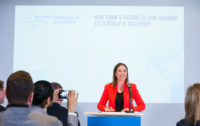Ask David Childs, of Skidmore Owings & Merrill, what he thinks the most important project in New York City is right now and his reply might surprise you—not the Freedom Tower, as you might expect, but the relocation of Penn Station from its current site under Madison Square Garden into a McKim Mead & White post office across the street.
“It’s the centerpiece of New York, it’s the front door,” Childs says. “It’s the piece that ties us together along to the whole East Coast and to the country.”
Moments like these highlight “New New York: Fast Forward,” an ambitious multi-media exhibit at The Architectural League of New York, on now through May 5 at the Urban Center, 457 Madison Avenue. Gregory Wessner, the show’s curator, interviewed 30 architects and is screening the results in a gallery full of DVD players.
Discussion topics in these films, which average five minutes apiece, included how to reconcile preservation with the ambitions of contemporary architecture; whether or not architecture is always good for a city; and the Moses v. Jacobs debate sparked by a series of Moses retrospectives and symposia this winter.
In addition to Childs, Wessner interviewed a who’s who of architects including Deborah Berke, Hugh Hardy, Richard Meier, and Ronnette Riley. All of the interviews will be made available later this month at www.archleague.org. Excerpts, courtesy The Architectural League, can be viewed at left.
While much of the show is local in focus, describing projects under construction around New York, many of the themes discussed apply to cities worldwide. Michael Sorkin, for instance, talks about how architecture can either unite or separate people by becoming a marker of privilege and wealth. And Greg Pasquarelli, of SHoP Architects, explains why he thinks architecture is the last refuge of the generalist.
“New New York” is the fifth in a series of show examining the city’s growth that the league has sponsored since 1998. Lewis.Tsurumaki.Lewis designed and installed the exhibition. The centerpiece is a model of the city, made of aerial photos and postcard-sized renderings, that depicts roughly 560 current and future construction projects throughout the city’s five boroughs. It was inspired by the much larger New York City Panorama that Robert Moses commissioned for the 1964-65 World’s Fair.



